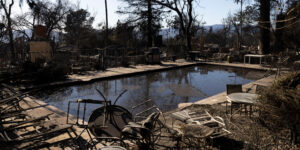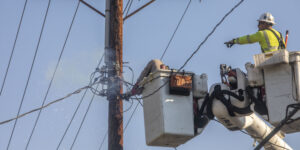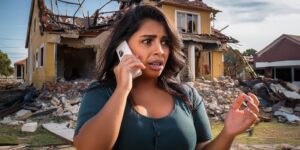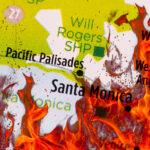In 2008, the year the stock market crashed and Barack Obama won the presidency, the U.S. was hit with a weather phenomenon little noted by anyone beyond the insurance industry.
The country’s losses from hail breached $19 billion in inflation-adjusted dollars that year, far exceeding the $8 billion to $12 billion norm seen previously.
By itself, that was a curiosity. But consider this: Damage from hail then continued to sit near $19 billion or higher in each of the next 10 years, according to Steve Bowen, a meteorologist for Aon, a risk assessment firm. It’s a surprising run of events that has spurred an ice-encased mystery among weather watchers: Why then, and why since?
“There are a number of scientific and socioeconomic reasons that can explain why U.S. thunderstorm losses have increased over time,” Bowen said by phone. “But it remains a bit of a headscratcher as to why 2008 seems to be the magic year that started this trend.”
Frozen Rain
Hail forms in thunderstorms when updrafts blow rain so high it freezes, according to the U.S. National Severe Storms Laboratory in Norman, Oklahoma. Those pellets grow as they collide with super-cold water drops that freeze on contact, adding more ice until gravity wins the battle with the wind and the pellets comes crashing out of the sky.
Hail stones come in all sizes. In 2010, for instance, an 8-inch (20 centimeters) Vivian, South Dakota weighing in at just under 2 pounds (0.9 kilograms) and setting a new U.S. record. However, it remains unclear whether the size of hail has anything to do with the rising costs.
Just one year, 2011, saw a dramatic increase in the number of hailstorms following 2008. With a La Nina holding sway in the Pacific, 2011 was marked by nine large outbreaks of severe thunderstorms and tornadoes from the Rocky Mountains through the Midwest and into the U.S. South, according to the National Centers for Environmental Information in Asheville, North Carolina.
“Hail is a bit challenging for us to confidently quantify because it is all based on eyewitness reports,” said Robert Jeffrey Trapp, head of the Atmospheric Sciences department at the University of Illinois. “It only gets reported if someone reports it. People are pretty bad at estimating size.”
While no one seems able to pinpoint why costs expanded starting in 2008, there are clues that suggest why they’re generally higher. There’s probably more things to hit, and they may be more valuable, the experts say.
“People are moving from the urban areas to the suburbs, and from the suburbs to the exurbs,” said Patrick Marsh, a warning coordination meteorologist at the prediction center. “And so cities are getting bigger. And as cities expand, that is more area for severe storms to impact. Ten years ago, the storm was outside the city limits. It may be in the city limits by now.”
More Expensive Things
While it’s logical to say there are more people with more expensive things that can be broken, that answer doesn’t completely answer what’s happening, said Ernst Rauch, head of Climate and Public Sector Business Development for Munich Re, a Germany-based reinsurer.
His company raises premiums as property values increase, he said, but the costs from hail are overwhelming the numbers in both the U.S. Midwest and Europe changing the probabilities.
The worst U.S. losses are in an area that starts midway through North Dakota and then follows the Great Plains into Texas, according to FM Global, a Rhode Island-based industrial insurer. Damaged roofs are among the biggest ticket items for FM Global’s clients.
From 1997 to 2006, FM Global’s clients lost about $32 million per year on average. From 2009 to 2018, however, those costs jumped to $130 million a year, according to data supplied by the insurer.
At the same time, forecasters say the increased losses have nothing to do with storm frequency. “It has more to do with what gets hit,” Marsh said. “One hail storm in Denver would take you 10% of the way to a $10 billion loss.”
While no one can say for sure what is driving the losses, the odds are they’ll continue to rise in a time of climate change, Trapp said.
Why 2008, and why since?
“It is an open research question,” said Andreas Prein, a researcher at the National Center for Atmospheric Research in Boulder, Colorado. “And as far as I know, nobody has an answer to that. It might be maybe just luck that in the last 11 years, hail storms just hit the big cities randomly.”
Photo credit: NOAA




















 Why All the Fuss? Fairness Regulations Meet Insurers’ Growing Use of AI
Why All the Fuss? Fairness Regulations Meet Insurers’ Growing Use of AI  Mercury General Wildfire Losses Will Hit Reinsurance Cover. One Event?
Mercury General Wildfire Losses Will Hit Reinsurance Cover. One Event?  Reinsurers in Growth Mode Brought Capacity, Flexibility to 1/1 Renewals
Reinsurers in Growth Mode Brought Capacity, Flexibility to 1/1 Renewals  Commercial Property Market Stabilizing, With Ample Capacity: USI
Commercial Property Market Stabilizing, With Ample Capacity: USI 




